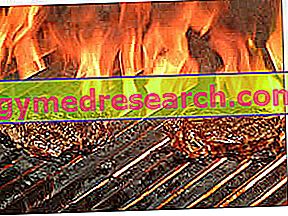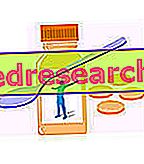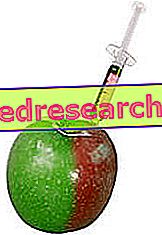Through the cooking of foods, numerous modifications occur to the nutritional principles; among these, some are positive and beneficial for human nutrition, while others are negative.

Protein denaturation - a positive aspect
The cooking of proteins, or rather the cooking of foods containing proteins, involves first of all the structural modification of peptides called protein denaturation. Specifically, by protein denaturation we mean the physical distortion of the secondary, tertiary and quaternary structures of proteins, which occurs by breaking the stabilizing bonds (such as the disulfide bridges). Denaturation is a positive aspect, indeed, it is the fundamental objective for which it is important to cook the proteins that, through this process, lose their original biological function and tend to coagulate, aggregate and lose solubility.
Denaturation starts at temperatures of about 60-70 ° C and is facilitated by acid pH (<7) and / or coagulant-digestive enzymes.
Release of hydrogen sulfide or hydrogen sulfide or hydrogen sulfide - a negative aspect
The denaturation of proteins during cooking also presents an unpleasant aspect; in some foods, such as egg or milk, consequently the disulphide bridges break, hydrogen sulphide or hydrogen sulfide or hydrogen sulfide (H 2 S) is released.
H 2 S is a toxic compound that acts negatively on the cells of all tissues (except red blood cells) because it inhibits mitochondrial respiration; obviously, by simply cooking the food, the release of H 2 S is minimal and of extremely reduced importance ... but for fairness, it is worth remembering.
Protein hydrolysis - a positive aspect
In addition to the denaturation of complex protein structures, cooking proteins increases their digestibility also by virtue of the hydrolysis of peptide chains (also facilitated by an acid environment and / or specific enzymes); this reaction is manifested by rupture of peptide bonds and leads to differentiation into smaller amino acid chains which are more easily attacked by digestive juices.
Alteration of the side chain of amino acids and oxidation of the radical group - a negative aspect
Cooking the proteins at temperatures> 100 ° C modifies the side chain of some amino acids and, sometimes, (in the presence of oxygen) causes the oxidation of the radical group (R). The most sensitive amino acids are: sulphurized : cysteine, cystine, methionine (which, as anticipated, can release hydrogen sulfide) and heterocyclic ones: tryptophan, tyrosine and histidine (tryptophan, in firings> 200 ° C, can be converted into polycyclic aromatic hydrocarbons ).
Maillard reaction - a negative aspect for health but (in moderation) positive for the palate ...
The Maillard reaction (Louis Camille Maillard 1912) determines the formation of brown and tasty compounds with cooking (polycyclic aromatics) and is based on the union of amino groups of proteins with simple sugars.
Maillard mechanism: 1) condensation of the NH2 group of an amino acid with a carbohydrate and consequent production of a Shiff base ; 2) transformation of the Shiff base into an Amadori product ; 3) transmutation of the Amadori product into polycyclic aromatic hydrocarbons - which by cooking give the food a brown color and a "cooked" flavor - but also in intermediate compounds such as hydroxymethylfurfural (HMF) or melanoidins .
NB . From the nutritional point of view, the Maillard reaction involves the partial loss of the amino acid lysine and a reduction in the digestibility of melanoidins because it is indigestible.
Ultimately, it is possible to affirm that the cooking of the proteins or the foods that contain them, involves positive aspects such as: the denaturation of the secondary, tertiary and quaternary structures, and the protein hydrolysis with the release of amino acids and / or peptides; however, cooking the proteins also determines several negative aspects such as: the release of H 2 S, the alteration and oxidation of the side chains and the radical chains belonging to the amino acids, and the activation of the Maillard reaction. These unwanted alterations can be attenuated by avoiding exposing the protein foods to high cooking temperatures, reached, for example during frying or grilling on an open flame. It should be remembered, in conclusion, that the cooking of protein foods par excellence (fish and meat) is fundamental to prevent various types of food poisoning; in this regard, see the articles: raw fish and raw meat. As for eggs and legumes, which are also rich in proteins, cooking is important to inactivate anti-nutrients that could damage the body.



